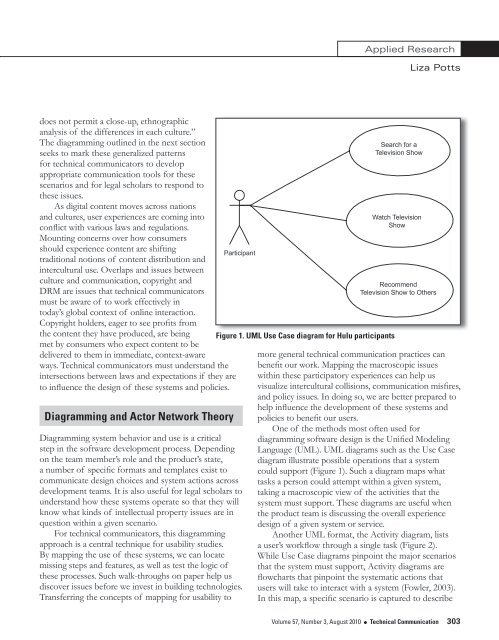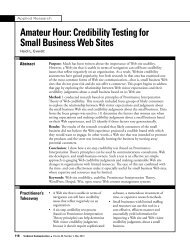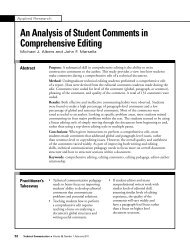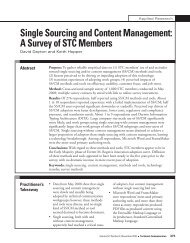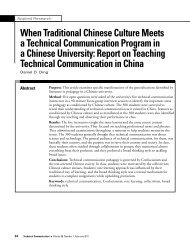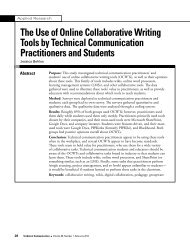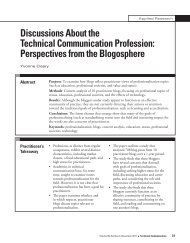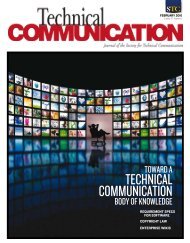Applied ResearchConsuming Digital Rightscompany The Pirate Bay. Active locations wherethese issues are occurring include Hulu, Amazon,and numerous sites where users can download orview content—whether legally through sites such asNBC or illegally through other servers. Although sitessuch as Hulu and Netflix have the copyright holder’sauthorization to host and distribute content, YouTubeand other third-party sites are rife with illegal content.According to Arnab and Hutchinson (2005, p. 3),“while DRM protected media is often sold as the user‘buying’ the digital work, the actual process is morelike licensing.” It is the confusion over this issue thatmost affects the user experience, which is complicatedby international issues.Laws regarding DRM vary from country to country.For the focus of the cases later in this article, the lawsof the United States and the European Union (EU)are most relevant. The World Intellectual PropertyOrganization (WIPO) is part of the United Nations. In1996, the WIPO Copyright Treaty (WCT) was signed,requiring member nations to implement laws againstcircumventing DRM. As part of this requirement, in1998 the Digital Millennium Copyright Act (DMCA)was passed in the United States. In 2001, the EUadopted the European Directive on Copyright. Insome instances, incidents occur when geography andcitizenship come into conflict with these DRM laws.In mapping these experiences, the focus is on theperspective of users trapped within these systems.Certainly, mapping can be done from the perspective ofthe corporations, but that is not the goal of the types ofdesign exercises for technical communicators discussedin this article.In addition to preparing technical communicatorsfor designing systems, an understanding of DRM andcopyright issues can empower us as user advocates.These issues are critical to technical communicatorsbecause these laws, policies, and incidents have a directeffect on the experiences we build for our users. Inlight of recent decisions made by product managers,intellectual property lawyers, and policy makers, ourrole as advocates for our users is critical if we are tosee improved experiences that can transcend nations,systems, and technologies.Brief Background on TechnicalCommunication and International IssuesTo understand the impact of these issues for the field,we must briefly look at research in international andintercultural issues in general and copyright specifically.It is imperative that technical communicators be involvedin these design and policy conversations. Regarding theissue of technical communicators working on theseinterface design issues, Bill Hart-Davidson (2001, p. 146)asked, “Why not us?”—a question that informationdesigners, information architects, and content developershave already successfully answered as they take theirplaces on product development teams. There is astrong, still-evolving movement within the field tofocus on these issues. As Michael Albers (2005, p. 271)reflected on the future of the field, “The knowledgerequired for developing, arranging, and presentinginformation requires an understanding of the varioustechnologies and tools available and an understandingof how the audience responds to those technologiesand tools. Writing is only one element of providing thatinformation; to ignore the other elements is to ensureboth our long-term obsolescence and lack of power andrespect within the project team and corporation.”Recent moves in technical communication towardredefining our research and assumptions concerninginternational and intercultural issues have led to anemerging set of research aimed at investigations into“audience, purpose, rhetorical patterns, and documentdesign” (Hayhoe, 2006, 141). Studies examining issuesof ethics and intercultural issues (Voss & Flammia,2007) give insight into the difficulties of navigatingcultural differences in writing. Studies addressing issuesof design give insights into localization (St.Amant, 2005)and internationalization (Zahedi, Van Pelt, & Song,2001). Arguments for writing material in the context ofthe culture within which it will be used (Wang & Wang,2009) are important for understanding how to design foryour users. In the case of laws, policies, and interfaces fortechnology, such an understanding is critical.In conducting international research, Thatcher(2001) stated, “For intercultural researchers to validlycompare two or more cultures, they must focus onthe more generalized patterns in each culture, which302 Technical Communication l Volume 57, Number 3, August 2010
Applied ResearchLiza Pottsdoes not permit a close-up, ethnographicanalysis of the differences in each culture.”The diagramming outlined in the next sectionseeks to mark these generalized patternsfor technical communicators to developappropriate communication tools for thesescenarios and for legal scholars to respond tothese issues.As digital content moves across nationsand cultures, user experiences are coming intoconflict with various laws and regulations.Mounting concerns over how consumersshould experience content are shiftingtraditional notions of content distribution andintercultural use. Overlaps and issues betweenculture and communication, copyright andDRM are issues that technical communicatorsmust be aware of to work effectively intoday’s global context of online interaction.Copyright holders, eager to see profits fromthe content they have produced, are beingmet by consumers who expect content to bedelivered to them in immediate, context-awareways. Technical communicators must understand theintersections between laws and expectations if they areto influence the design of these systems and policies.Diagramming and Actor Network TheoryParticipantDiagramming system behavior and use is a criticalstep in the software development process. Dependingon the team member’s role and the product’s state,a number of specific formats and templates exist tocommunicate design choices and system actions acrossdevelopment teams. It is also useful for legal scholars tounderstand how these systems operate so that they willknow what kinds of intellectual property issues are inquestion within a given scenario.For technical communicators, this diagrammingapproach is a central technique for usability studies.By mapping the use of these systems, we can locatemissing steps and features, as well as test the logic ofthese processes. Such walk-throughs on paper help usdiscover issues before we invest in building technologies.Transferring the concepts of mapping for usability toFigure 1. UML Use Case diagram for Hulu participantsSearch for aTelevision ShowWatch TelevisionShowRecommendTelevision Show to Othersmore general technical communication practices canbenefit our work. Mapping the macroscopic issueswithin these participatory experiences can help usvisualize intercultural collisions, communication misfires,and policy issues. In doing so, we are better prepared tohelp influence the development of these systems andpolicies to benefit our users.One of the methods most often used fordiagramming software design is the Unified ModelingLanguage (UML). UML diagrams such as the Use Casediagram illustrate possible operations that a systemcould support (Figure 1). Such a diagram maps whattasks a person could attempt within a given system,taking a macroscopic view of the activities that thesystem must support. These diagrams are useful whenthe product team is discussing the overall experiencedesign of a given system or service.Another UML format, the Activity diagram, listsa user’s workflow through a single task (Figure 2).While Use Case diagrams pinpoint the major scenariosthat the system must support, Activity diagrams areflowcharts that pinpoint the systematic actions thatusers will take to interact with a system (Fowler, 2003).In this map, a specific scenario is captured to describeVolume 57, Number 3, August 2010 l Technical Communication 303
- Page 1 and 2:
AUGUST 2010Volume 57 Number 3SPECIA
- Page 3 and 4:
PresidentMichael A. HughesVice Pres
- Page 5 and 6:
VoLuME 57, NuMBER 3AUGUST 2010ISSN
- Page 7 and 8:
Guest EditorialKirk St.Amant and Ma
- Page 9 and 10: Applied ResearchTechnical Communica
- Page 11 and 12: Applied ResearchNicole St. Germaine
- Page 13 and 14: Applied ResearchNicole St. Germaine
- Page 15 and 16: Applied ResearchNicole St. Germaine
- Page 17 and 18: Applied ResearchNicole St. Germaine
- Page 19 and 20: Applied ResearchNicole St. Germaine
- Page 21 and 22: Applied ResearchNicole St. Germaine
- Page 23 and 24: Applied ResearchNicole St. Germaine
- Page 25 and 26: Applied TheoryTatiana BatovaIntrodu
- Page 27 and 28: Applied TheoryTatiana BatovaMoreno,
- Page 29 and 30: Applied TheoryTatiana BatovaThe Uni
- Page 31 and 32: Applied TheoryTatiana Batovadoctors
- Page 33 and 34: Applied TheoryTatiana BatovaTo addr
- Page 35 and 36: Applied TheoryTatiana Batovathe loc
- Page 37 and 38: Applied TheoryTatiana BatovaJohnson
- Page 39 and 40: Applied TheoryTatiana BatovaInterna
- Page 41 and 42: Applied TheoryMcKee and PorterIntro
- Page 43 and 44: Applied TheoryMcKee and PorterFor e
- Page 45 and 46: Applied TheoryMcKee and Porterpubli
- Page 47 and 48: Applied TheoryMcKee and PorterBecau
- Page 49 and 50: Applied TheoryMcKee and Porterof th
- Page 51 and 52: Applied TheoryMcKee and Porterwith
- Page 53 and 54: Applied TheoryMcKee and PorterA Cop
- Page 55 and 56: Applied TheoryMcKee and PorterConte
- Page 57 and 58: Applied TheoryMcKee and PorterWalto
- Page 59: Applied ResearchLiza PottsIntroduct
- Page 63 and 64: Applied ResearchLiza PottsUser’s
- Page 65 and 66: Applied ResearchLiza Pottsactors, t
- Page 67 and 68: Applied ResearchLiza PottsDRM has a
- Page 69 and 70: Applied ResearchLiza Pottsmake bett
- Page 71 and 72: Applied ResearchLiza PottsOne viewe
- Page 73 and 74: Applied ResearchLiza Pottsinvolved
- Page 75 and 76: Applied ResearchLiza PottsHayhoe, G
- Page 77 and 78: Applied ResearchInternational Fair
- Page 79 and 80: Applied ResearchTyAnna K. Herringto
- Page 81 and 82: Applied ResearchTyAnna K. Herringto
- Page 83 and 84: Applied ResearchTyAnna K. Herringto
- Page 85 and 86: Applied ResearchTyAnna K. Herringto
- Page 87 and 88: Applied ResearchTyAnna K. Herringto
- Page 89 and 90: Book ReviewsWriting Successful Scie
- Page 91 and 92: Book ReviewsThe Process: Business P
- Page 93 and 94: Book ReviewsHCI Beyond the GUI: Des
- Page 95 and 96: Book ReviewsOrigins of the Specious
- Page 97 and 98: Book Reviewsgenre, and process, top
- Page 99 and 100: Book ReviewsPart One goes from the
- Page 101 and 102: Book Reviewsrather than writers, an
- Page 103 and 104: Book ReviewsHow to Write Fast Under
- Page 105 and 106: Book Reviewsmanagement system (CMS)
- Page 107 and 108: Book Reviewsnearly strangled when h
- Page 109 and 110: Book Reviewsinteractive TV model)
- Page 111 and 112:
Book ReviewsOtherwise, Beech shows
- Page 113 and 114:
Book Reviewssuch as blog, I found m
- Page 115 and 116:
Book Reviewsemployees and effective
- Page 117 and 118:
Recent & RelevantSherry Southard, E
- Page 119 and 120:
Recent & RelevantRecent & RelevantC
- Page 121 and 122:
Recent & RelevantRecent & RelevantE
- Page 123 and 124:
Recent & Relevantworking in a langu
- Page 125 and 126:
Recent & RelevantWhat’s the big d
- Page 127 and 128:
Recent & RelevantScientific Writing
- Page 129 and 130:
Recent & Relevantapplicability. Man
- Page 131:
Did You Missthe Summit?Don’t miss


